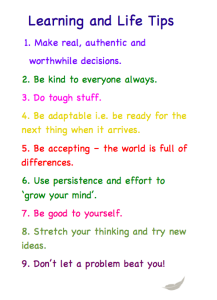Create a classroom environment using Learning and Life Tips gives you and your students new ways to think and reflect on management and behaviour outcomes.
Scenario:
Setting up your classroom environment at the beginning of the year always involves organising a list of rules – Class Rules / Code of Conduct. Examples – We must put up our hands to answer questions. We must walk safely around the classroom. We must respect other people’s property. We must keep our hands to our-self.
What impact do these ‘rules’ actually have? Do they create decision- making, problem solving and real life thinking in the classroom environment?
I found these traditional lists of little or no use helping me to develop the social, emotional and learning requirements of students. What could I do differently, what would make an impact, what would be useful everyday to make a difference? The Learning and Life Tips below evolved as I reflected on my ‘day to day’ work with students.
Try This:
Learning and Life Tips
- Make real, authentic and worthwhile decisions
- Be kind to everyone always
- Do tough stuff
- Be adaptable i.e. be ready for the next thing when it arrives
- Be accepting – the world is full of differences
- Use persistence and effort to ‘grow your mind’
- Be good to yourself
- Stretch your thinking and try new ideas
- Don’t let a problem beat you!
Inform students that these are the ‘Learning and Life Tips’ for our classroom. These tips can transfer and be used in your playground and home environment also.
Idea to Introduce the Tips:
– Select 8 students to work in front of the class with you.
– Give them one tip each to read out loud. Explain each tip and ask for contributions from the students.
All students from Prep (Foundation) to Year 6 and onwards understand the tips quickly and easily. If a problem occurs or great thinking and learning is happening throughout the day make a statement to the student or the class using the list as a reference. e.g.
Are you doing authentic thinking when you state that ‘aliens landing on earth is a ten on the Catastrophe Scale’ – that’s ‘creative thinking’, I need you to have authentic, real thinking – Ok?
Please use your real voice when you talk to me, (great for those students that revert to baby talk).
I notice that you are always kind to others, that is such a great personal skill to have.
‘Yes this work is hard, it is important to do tough stuff at school.’
Top work, I can see you are being persistent and using effort to get things done.
What a worthwhile decision you have made to choose your Optimal Learning Spot and sit by yourself today. I can see that you really want to concentrate and get the task finished, great stuff!
Is that a worthwhile decision to interrupt me when I am teaching. I understand and know you have ideas too so I will get back to you when I am finished. OK?
Great effort, I can see you are being good to yourself because – you have chosen to sit in a place that allows you to get on with your work, all your lunch has been eaten, you have your water bottle with you, you made a positive contribution to your group, you were very adaptable today and managed to sort your problem.
Are you really being good to yourself when you sit and do nothing, throw your lunch in the bin, swear, call someone names, scribble on your work?
Wow, what an idea, I can see you like to think differently.
Never allow students to groan if you have to change something. Point out that they must be adaptable and ready for the next thing when it arrives – it’s an important life skill.
Today sport has been cancelled due to the wet weather. We have to be accepting, we can’t always have what we want.
Outcomes:
- Learning and life Tips can be used any time in the school day.
- Individual Tips can be selected to suit any scenario that occurs in the classroom or playground.
- Students respond to the word ‘Tips’ rather than using the word ‘Rules.’
- ‘The Learning and Life Tips’ list is very useful as a quick checklist at the end of an activity. Did we…? Go through the list and tick all the Learning and Life tips that were achieved. If not generate some quick ideas to develop the Tip/solve the problem -refer to the ideas at the start of the next session.
Tips:
- You need to use energy and effort to remember to use the Tips in your daily teaching.
- Use the Tips at any time of the day (note – it is not essential to constantly use the tips every single day).
- At the beginning of a session you might nominate a few Tips that will be needed during the session. Eg Group Work
– Make real, authentic and worthwhile decisions
– Be adaptable
– Be good to yourself
- Review at the end, take a few notes to feedback at the end of the session, record students names next to the selected Tips to recognise their contributions and allow students to record the name of someone who demonstrated one of the selected Tips.
- These ideas are easy to implement and will build on your class culture of life long learning.
- A final idea to give students ownership of the list of Tips:
– Students can illustrate possible scenarios to add to the poster.
– Students make the entire poster for the classroom, add a border, illustrations, and write each tip in different colours
– Students present the completed poster to the class and decide where it will be displayed.
Click here for copy of the Learning and Life Tips poster to use in your classroom.
